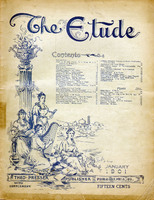ROBERT GOLDBECK.
Polyphony refers to that style of musical composition most fully represented by the fugue, in which two or more independent voices or parts continue their play from beginning to end. During the earlier period of fugal development, the accords and discords arising from the meeting of the voices were principally incidental harmonies.
Hopping out of the narrow circle of canonic and fugal law, harmony became a freer and even greater force in the musical form which by that means gradually assumed symphonic proportions. In this larger, freer form polyphony was no longer the aim, it became the means of giving depth, diversified life, and character to musical composition. Polyphony at first was imitation, according to pre-established rules; modern polyphony is imitation, but without any limits, free to occur at any time, in any voice—or to discontinue and reappear at will, often ceasing altogether and changing into homophony when a single musical thought prevails, supported and harmonized by other parts.
Polyphony has almost exclusively been restricted, in modern composition, to two contrasted parts, connected with a more extended system of motive-work, the motive being a fragmentary musical phrase. It becomes, as in Beethoven, the marrow of the composition, giving it energy, unity, and musical meaning.
It is the distinguishing prerogative of music to have many tones (polyphones) sound simultaneously—of multitudes taking part in its manifestation at the same moment. This integral property renders the polyphonic principle eternal, forever pursuing its evolutionary course toward perfection.



